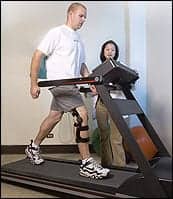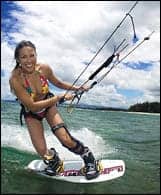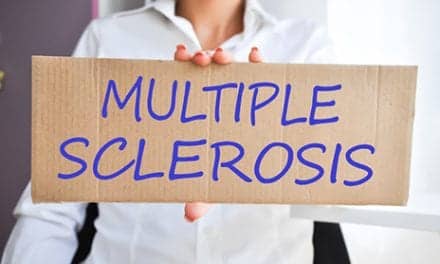 |
| Suzanne Kwan, PT (right), monitors client Scott Lockwood’s postsurgical physical therapy at Centinela Freeman Regional Medical Center, Centinela Campus, Los Angeles. |
“When I was 19 I had a torn ACL and I was misdiagnosed for 30 years, and am I grateful for that,”says Charles Barocas, CO, ROT, president and founder of the American Society of Orthopedic Professionals (ASOP). “If I had been diagnosed correctly, I would have had a total knee replacement. But it healed on its own, and it’s never bothered me. I have friends who got a torn ACL while skiing and 20 years later still have problems.”
Surgery is an appealing option to traditional casting, which can take up to 11 months to heal, Barocas says. “When it’s treated with plates and screws, you’re told you’ll be able to put stress on it sooner and so heal faster,” he continues. “And, you’re promised a perfect alignment.”
However, the leg should feel a certain amount of stress, Barocas explains, for that is its way of telling the rest of the body to send nutrients down to the injury. The result can be that the knee heals faster, but not necessarily fully, so repeat injuries or complications can occur in later years. And perfect alignment is not always perfect for the body. Even if the alignment is off a degree or so, it does not matter in terms of function.
“Recently, at a symposium of the American Academy of Orthopaedic Surgeons, a number of doctors came up to the podium and recanted, stating that the procedures they were doing a few years ago were a mistake,” Barocas says. “People were told, ‘If you get this perfect alignment now, in 20 years you won’t have arthritis.’ But studies have shown that for those with similar injuries who had surgery and those who did not, the result was there is no evidence that those who avoided surgery got arthritis as a result. If the person did proper rehabilitation, the muscles and ligaments healed naturally.”
Moreover, avoiding surgery does not necessarily mean that the patient has to submit to the long immobilization of the traditional cast. Just the contrary. “We now know that the range and stress forces are very important in healing fractures,” Barocas says. “Casts provide immobilization, but also hinder circulation. And circulation is the key to healing. The more we can promote circulation to the affected limb, the faster the bone will heal.”
Barocas says that as the director of ASOP and the main instructor in its casting and bracing workshop, “We now promote early mobilization. We do this by designing an area for micromovements within the cast. Through early mobilization, we shorten the time the patient needs to be in the cast and also shorten the need for rehabilitation.”
IMPORTANT CONSIDERATIONS
 |
| Kite surfer Nina Johannson demonstrates the effectiveness of a custom sports brace. |
“The important things to consider any time you have a patient being splinted into immobility are the detrimental changes that can occur,” says Edward W. Bezkor, PT, DPT, MTC, clinical specialist of outpatient physical therapy, NYU Medical Center, Rusk Institute of Rehabilitative Medicine, New York City. “There are fibrotic changes in the tissues and fascial thickening. There is the loss of sarcomeres, the contractile unit of muscle fiber most apparent when the muscle is held in a shortened range. Another two things that can happen are the degeneration of the cartilage, because there will not be the healthy stresses placed on the cartilage and the motion of synovial fluid. This loss of lubrication causes the binding of connective tissue.”
That being said, Bezkor adds, “Bracing and splinting play a definite role in protecting a patient’s biological and mechanical structure following an injury. So the emphasis in current therapy is the use of bracing and splinting as protective measures while the soft tissues are healing and are at a risk for injury.”
Bezkor points back to the 1970s when ACLs were repaired by a surgical incision into a joint along with extra-articular reconstruction. This was fairly invasive and did not work very well, Bezkor continues. During the 1980s, as arthroscopic surgery and intra-articular reconstruction were perfected, this allowed for accelerated rehabilitation with earlier motion. However, in the 1990s, the societal pressure to return athletes to their sports more quickly placed an added emphasis on the rehabilitative bracing as more fully capturing the natural recuperative powers of the body.
|
Read more about sports bracing, and related topics, by searching our online archives. |
|
There is still some controversy among surgeons who, not surprisingly, tend to favor surgery, and PTs, who favor working with the body to heal itself. Another controversy, Bezkor says, has to do with the transitional rehabilitative brace and the functional one. “During the protective phase of rehabilitation, the transitional brace has been shown to be effective at protecting the graft site, while initiating range of motion, weight bearing, and muscle strengthening,” he explains. “The controversy occurs after this state with the question as to whether or not a functional brace is important for the patient to wear when returning to athletics.”
But the current research, Bezkor says, “shows that after the healing phase functional bracing has no effect on the range of motion, laxity, strength, pain, functional testing, or patient satisfaction. In addition to all of the negatives mentioned above, it’s been shown that utilizing braces 1 to 2 years after the injury leads to decreased quadriceps strength.” In fact, he adds, 36% of physicians have decreased their functional brace prescriptions.
In addition to knee injuries, another lower-extremity injury that is common, especially in sports, is the ankle sprain, which, Bezkor says, comprises “13 to 56 percent of all injuries in sports requiring running or jumping. Thirty percent have chronic symptoms of pain and instability. The current literature supports rehabilitation with an earlier return to activity. This lessens the chance of later symptoms of pain, stiffness, and muscle weakness.”
IMPROVING STRENGTH AND FLEXIBILITY
 |
| According to experts, active individuals and athletes should use a custom-fitted brace. |
The same dynamics are at work in both knee and ankle injuries, and that’s getting the patient moving earlier. “And that’s where we physical therapists come in,” Bezkor says. “We are skilled at improving strength and flexibility along with the kinetic change, as well as improving proprioception, or a patient’s sense of where the joint is positioned in space. This helps the patient regain normal coordinated motor function and decreases the risks of reoccurrence.”
Brian P. Hagen, DPT, MS, PT, OCS, FAAOMPT, program administrator and facility director of the Center for Sports Medicine at the University of Pittsburgh Medical Center, points out that what has helped accelerate this trend toward bracing has been the introduction of new material during the past several years.
The role of the PT has these trends. “Typically, the physical therapist will make the recommendation for a particular type of brace, whether it’s off the shelf or custom made,” Hagen says. “The therapist often works with the physician and athletic trainer, making measurements and instructing the patient on proper usage.”
Thomas G. Dolan is a contributing writer for Rehab Management. For more information, contact .
Correcting Deformity with Early Bracing Techniques
Charles Barocas, CO, ROT, president and founder of the American Society of Orthopedic Professionals (ASOP), credits the current trend toward rehabilitative bracing to orthopedic surgeon Augusto Sarmiento, MD. Barocas adds that in the past 3 months ASOP has also incorporated the work of Ignacio Ponseti, MD, who revolutionized a natural casting and manipulation treatment for infant clubfoot without the need for surgery, which was the traditional method, and had extremely poor results.
The irony is that the bracing innovations of Sarmiento relating to tibia and humeral fractures began in the 1960s, but they still are not universally accepted. And Ponseti began his pathfinding efforts in the 1950s. He gained some acceptance, but, when he retired, it appeared that his breakthroughs were going to fade with him. So, although he was long retired, he decided to come out of retirement at age 82 to publicize and promote his treatment. He is now 92, and still active.
His efforts have been fruitful.
“The use of Dr Ponseti’s treatment for clubfoot has been one of the most exciting trends in the past 10 years,” says Matthew B. Dobbs, MD, assistant professor, orthopedic surgery, Washington University School of Medicine, St Louis. “One of the problems with clubfoot is that even if there appears to be an initial success, if the treatment has not been done correctly, the condition can reoccur. We have the advantage of being able to follow Dr Ponseti’s patients for 40 to 50 years. As adults they are functioning extremely well, with flexible and pain-free feet.” Just the opposite is true for those who have been subjected to surgery, and more surgery.
As soon as possible after birth, the doctor prepares a cast for the child’s foot. The treatment involves weekly stretching of the foot deformity in the clinic, followed by the application of the long leg plaster cast. The cast is changed every 1 or 2 weeks, and the rhythm is generally 1 week with the cast on, and 1 off, with the foot stretching and massaging in-between. The deformity is usually corrected in about 5 to 6 weeks.
Before the application of the final cast, the physician usually performs a tenotomy, an Achilles tendon lengthening using noninvasive surgery. The surgery is so small that no stitching is required. The child wears a final cast for 3 weeks to allow the tendon to heal. He then wears a corrective brace full-time for 3 months, 23 hours per day. This is followed by night and naptime wear for 3 to 4 years.
Dobbs, who studied under Ponseti, is one of the leading proponents of this method, and he has adapted the same principles for the treatment of congenital vertical talus or rocker-bottom flat foot.
In sum, the trend appears to be toward rehabilitative bracing, which will help the body heal naturally—what PTs do very well.
—TGD
Increasing Stability
By Frank Long
Clive Brewster, MS, RPT, of the Kerlan-Jobe Orthopaedic Clinic in Los Angeles has administered rehabilitation programs to athletes ranging from nameless weekend warriors to home-run colossus, Barry Bonds. Whether nursing an ankle or emerging from an anterior cruciate ligament procedure, Brewster says what athlete-patients most need from a brace is increased stability.
“If you’ve torn the ligament the joint is not as steady as it should have been, so they [use a brace] for additional support so they can go out and play again,” Brewster says. “If you’re looking at a hand or an ankle they can do taping, but when it comes to the knee you talk about a brace.”
Brewster says off-the-shelf braces are acceptable for the activities of daily living, but for athletes who want to get back into game form, a custom-fitted brace is necessary. Selecting a brace, Brewster adds, is highly individualized, and he notes that a brace used by a football player may not work for a basketball player.
“You can’t always get away with a brace,” Brewster says. “In sports where the player does a lot of pivoting and cutting and turning, they’ll need to have surgery.”
Brewster most frequently treats those who are healing from ACL reconstruction. Skilled surgical technique and a proper rehabilitation, he says, can reduce the role of braces after ACL procedures. “If the surgeon did a really wonderful job and tightened up the ligament and tightened up the joint, I don’t think a brace is needed after that. If the patient gets good strength and endurance, and his flexibility is there, it’s almost like new.”
Frank Long is the associate editor of Rehab Management. He can be reached at .



